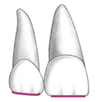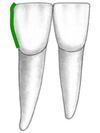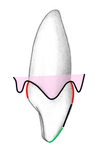Incisor Comparisons Flashcards
Numbers of the maxillary incisors, from quadrant 1 to 2
- 2
- 1
- 1
- 2
3 variations of norm for Maxillary central incisors (buccal view)
Triangular
Ovoid (thought to be female)
Square (thought to be male)

Maxillary muccal view: Compare crown form of central vs. lateral incisor
Central = square
Lateral = oblong

Maxillary Buccal view: Compare crown and root dimensions of lateral and central incisor
- Lateral smaller M-D
- Lateral shorter I-C by approx. 2 mm
- Crown and root are closer in length on central incisor

Maxillary Buccal view: Compare incisal edge form of central and lateral incisors
Lateral = more curved, central = straighter

Maxillary Buccal view: Compare mesio-incisal and disto-incisal angles
Lateral = more rounded
Central = M-A angle sharper (more square) than D-I angle

Maxillary Buccal view: Compare proximal surface forms
More convex on lateral incisor
Straighter on central incisor

Maxillary Buccal view: Compare proximal contacts of central and lateral incisors
Mesial and distal contacts are located farther cervically on lateral incisor

Maxillary Buccal view: Compare root apex form of central and lateral incisors
- Sharper on lateral incisor
- Curves distally on lateral incisor

Theory to explain distal curve of root on lateral incisor
As teeth reupt, jaw grows forward and tooth continues to grow with jaw
Maxillary Palatal view: Compare cingulum form of central and lateral incisor
Central incisor has a broader M-D cingulum with smooth convex surface

Maxillary Palatal View: Compare marginal ridge prominence of central and lateral incisors
M and D ridges more prominent on lateral incisor

Maxillary Palatal view: Compare lingual fossa of central and lateral incisors
Smaller and deeper on lateral incisor

Maxillary Palatal view: compare lingual pit/groove of central and lateral incisors
More commonly found on lateral incisor

Maxillary Mesial view: compare crown size of central and lateral incisors
Central incisor has larger B-Li and I-C crown dimensions (on right)

Maxillary Mesial view: Compare cervical line curvature of lateral and central incisors
Less curvature on lateral incisor (on left)
More prominent on central incisor (on right)

Maxillary mesial view: compare incisal edge thickness of central and lateral incisors
Thicker B-Li dimension on lateral incisor

Maxillary mesial view: compare triplanar buccal surface of central and lateral incisors
Emergence profile is more prominent on central incisor
In general:
- Middle-half is straight with slight convexity
- Incisal half slopes toward incisal edge

Maxillary incisal view: compare the buccolingual crown dimension of the central and lateral incisors
Smaller on lateral incisor

Maxillary incisal view: compare the surface convexity of the lateral and central incisors
More convex on lateral incisor

Maxillary incisal view: compare the M-B and D-B line angles of the central and lateral incisors
More rounded on lateral incisor (i.e. less angular)

Mandibular buccal view: compare the crown dimensions of the lateral and central incisors
Lateral incisor crown has larger M-D and I-C dimensions

Mandibular buccal view: compare the incisal edge form of the central and lateral incisors
Straight on central incisor
More curvature toward the distal on lateral incisor

Mandibular buccal view: compare the distoincisal angle of the central and lateral incisors
Slightly more rounded on the lateral incisor

Mandibular buccal view: compare the distal proximal contact of the central and lateral incisors
Slightly more cervical on lateral incisor

Mandibular buccal view: compare the distal surface convexity of the lateral and central incisors
More convex on the lateral incisor

Mandibular buccal view: Compare root length
Longer on lateral incisor

Manidbular buccal view: compare root width
Wider on lateral incisor

Mandibular mesial view: Compare the buccolingual and root dimensions
Larger on lateral incisor

Mandibular distal view: compare the distal proximal contact
Slightly more cervical on lateral incisor

Mandibular incisal view: compare the incisal edge to buccolingual bisector
Perpendicular relationship on central incisor (mesiodistal symmetry)

Mandibular incisal view: crown rotation on root comparison
Crown of lateral incisor appears rotated distally on root

Mandibular incisal view: compare the crown symmetry
Central incisor is symmetrical
Laterla incisor is not due to rotation

Profile of maxillary central incisor
Red = emergence profile
Black = central
Green = incisal



